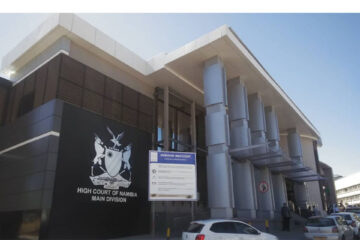Ester Mbathera
The country’s Environmental Impact Assessment (EIA) system faces accusations of failing both communities and the environment, according to a report released by the Namibian Environment and Wildlife Society recently.
Authored by John Pallett and Ndelimona Iipinge, the report highlights deficiencies in the EIA system.
“The whole process appears to be a box-checking exercise that serves a wealthy and well-connected few at the expense of the majority of Namibians and our environment,” reads the report.
One example cited involves an Exclusive Prospecting License (EPL) near the //Huab Conservancy in the Khorixas area, which is home to a number of rhinos.
“The Environmental Clearance Certificate (ECC) was issued despite this clear irregularity and major negative impacts, and the geological exploration project has gone ahead,” reads the report.
The geological exploration project proceeded, further exacerbating concerns.
According to the authors, this and other similar examples reinforce the view held by many that the EIA process cannot be trusted.
“It is at best just an administrative procedure to tick the ECC box, or at worst, an area of growing concern about corruption,” read the report.
The report criticises the current EIA framework as ineffective and, at times, exploitative, citing a lack of public engagement, unqualified EAPs, and inadequate oversight by the Department of Environmental Affairs (DEA).
Public input, according to the report, is often downplayed or ignored.
“No qualification is required for EAPs, and young entrepreneurs see EIAs as an easy business opportunity. EAPs are eager to please the developer and willing to bend rules and cut corners to do so. The government department overseeing EIAs is slow, opaque and unresponsive to suggestions,” reads the report.
Since May 2023, the authors have been monitoring EIAs through the EIA Tracker, a tool that provides information on projects applying for environmental clearance based on their Background Information Documents (BIDs).
The Tracker focuses on high-risk projects, such as large mines and dams with significant environmental and social consequences.
However, the authors found that information on EIAs post-May 2023 is not available on Namibia’s Environmental Information Service (EIS).
They claim the DEA deliberately restricts access to such details.
“This is a significant concern because the Environmental Management Plan (EMP) sets out how the project should be run and what it has undertaken to do to mitigate social and environmental impacts. This information is hidden from the public. As the Office of the Environmental Commissioner (OEC) seldom inspects projects, there is no accountability for EMPs being implemented,” reads the report.
Attempts to access public BIDs have also been obstructed, the report claims.
“Our attempts to do so have been an eye-opening exercise! In many cases, EAPs unlawfully refuse to provide the BID. These same practitioners are often associated with placing EIA adverts (another legal requirement) in obscure places, such as the tiny print of the classified ads section of a newspaper. These are deliberate measures by some EAPs to keep the EIA out of the public’s sight. The EIA Tracker has reported them to the Environmental Commissioner—with no response,” reads the report.
Of the 1189 EIAs registered with the DEA between May 2023 and July 2024, 52% were for low-risk projects with minimal environmental or social impact, such as urban rezoning, fuel stations, and solar farms outside sensitive areas.
The authors argue that such projects unnecessarily consume the DEA’s time and resources, which could be better spent on thorough evaluations of high-risk projects.
“These relatively trivial EIAs occupy a large proportion of the DEA’s effort and time, each taking about three months from submission of the EIA to issuance of the ECC. In our opinion, this is a wasted effort. They could more efficiently be handled through a simplified checklist, speeding up the process and freeing up time for more important matters, where more thorough due diligence on significant EIAs is needed,” they suggested.
The EIA Tracker team met with Mufeti and senior staff to discuss these challenges, proposing the establishment of a professional body for EAPs like those in the earth sciences, medical, and engineering fields.
According to the authors, despite Mufeti’s promise to prioritise this recommendation, little progress has been made.
Currently, only 48 of Namibia’s 93 EAPs are registered with the Environmental Assessment Practitioners Association of Namibia (EAPAN), and just 337 of the 1 189 EIAs conducted during the 15-month period were handled by EAPAN-registered practitioners.
“The Tracker has shown us that many aspects of the EIA process are currently failing in Namibia. Our message to the OEC, based on the solid facts revealed by the EIA Tracker, shouts out: Clean up your act! We call on the Environmental Commissioner to implement the Environmental Management Act in a professional manner as part of his duty to work on behalf of all Namibians.” said the authors.
Responding to the criticism, Mufeti defended the ministry’s transparency and regulatory compliance.
“The ministry is committed to enhancing transparency and accountability through clear channels and regulatory compliance. Anyone can request in writing to access EIA documents post-approval. Through the PR office, members of the press are equally provided access to EIA documentation,” he said.
He encouraged stakeholders to request EIA documents in writing and assured them that the ministry is committed to improving monitoring and accountability in EMP implementation.
While acknowledging concerns about the “box-ticking exercise” characterisation, Mufeti reiterated the ministry’s dedication to socially just and environmentally sustainable development.
“We operate under the clear legislative authority of the Environmental Management Act (EMA) No. 7 of 2007, which mandates the review and decision-making process for Environmental Clearance Certificates that ensures public participation and fosters sustainable development. The Ministry actively works to ensure that the EIA process goes beyond compliance and contributes to long-term environmental and social goals,” he said.




